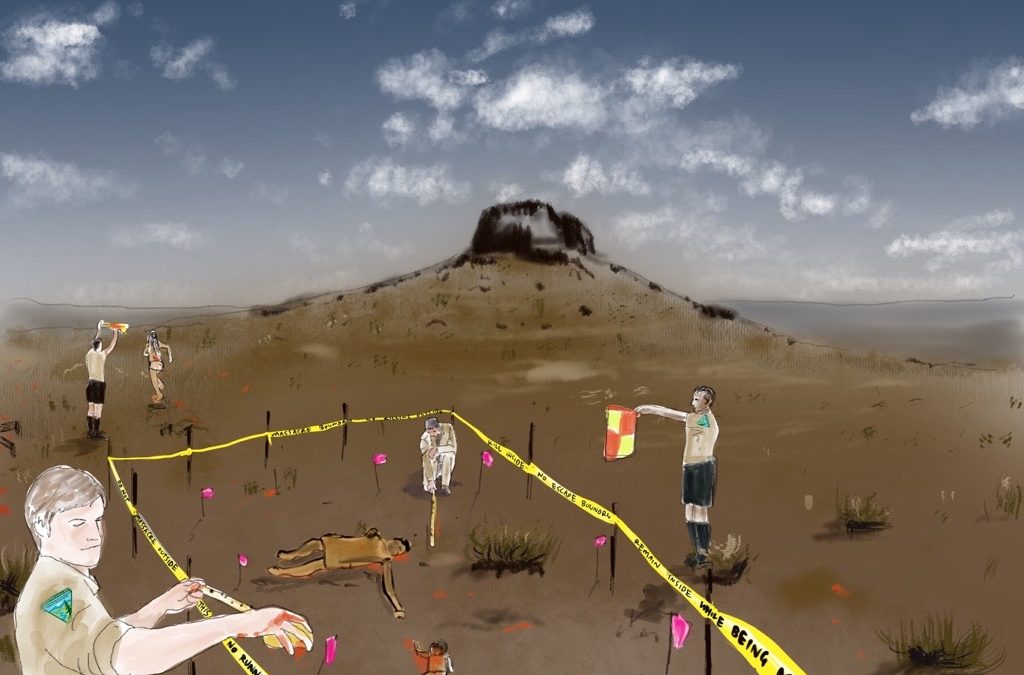Image by Deep Green Arts
As we recently reported, the Bureau of Land Management has finally acknowledged that the September 12, 1865 massacre did take place in Thacker Pass.
But the BLM hasn’t gained a conscience. Now, they are trying to wipe their hands clean by claiming that the massacre took place entirely on private land.
This is a lie, and the evidence contradicts BLM’s claim.
Regional tribes, including the Reno-Sparks Indian Colony, Summit Lake Paiute Tribe, and Winnemucca Indian Colony, have all asked BLM to recognize that the Thacker Pass massacre of 1865 extended across the entire landscape. So have dozens of members of the public who also sent letters.
One of these letters came from Alexa Roberts, former National Parks Superintendent of the Sand Creek Massacre Site and now Board Chair of the Sand Creek Massacre Foundation. As she lays out in her letter below, a massacre site is not limited to just the site where evidence of a massacre has taken place; it includes all the components of the massacre – the approach of troops, escape routes, essential landscape features, and more. The BLM, and Lithium Americas, would like to limit the definition of the “massacre site” at Thacker Pass as small as possible so as not to interrupt the proposed mine construction. We argue, as Ms. Roberts does in her letter, that this is far too narrow a definition of a massacre site, and that the entire Thacker Pass area should be added to the National Register of Historic Places and protected from development.
BLM has, to this point, ignored these letters and demands completely. (Contact BLM here)
August 14, 2022
To:
Ester McCullough
District Manager Winnemucca District Office
Bureau of Land Management
5100 East Winnemucca Blvd.
Winnemucca, NV 89445
RE: Snake War Massacre Site, Thacker Pass (Peehee Mu’huh) and Sand Creek Massacre site
Dear Ms. McCullough:
My name is Alexa Roberts and I have been affiliated with the Sand Creek Massacre Site in Kiowa County, southeastern Colorado, for nearly 25 years, beginning with the National Park Service’s first efforts to locate the site and designate it as a national historic site, then as the first site superintendent, and now as the Board Chair for the non-profit Sand Creek Massacre Foundation. As such, I have been extremely interested in learning about the site of the 1865 massacre of Paiute people at Thacker Pass (also known as Peehee Mu’huh) and its ongoing significance to the cultural identity of the Northern Paiute and Western Shoshone people.
Descriptions of the site according to historical accounts bear striking similarities to what is known about the 1864 massacre of Cheyenne and Arapaho people at Sand Creek in what is now southeastern Colorado.
Both surprise attacks were carried out by U.S. Volunteer cavalry against non-combatant Native people, under cover of darkness in pre-dawn hours as the victims slept. At both Sand Creek and Peehee Mu’huh, troops split into two groups and attacked, causing the unsuspecting victims to flee. Both atrocities were “running engagements” in which troops pursued their intended targets over many hours and over many miles. Both resulted in the murders of innocent men, women and children, and the subsequent, deliberate destruction of the villages’ stores of food and supplies.
The historical analogies go on, but the difference today is that the site of the Sand Creek Massacre has been set aside by and for the people of the United States as a National Historic Site – one of the greatest possible testaments to its national significance. Through this designation the United States has acknowledged the true legacy of the Sand Creek Massacre, for the nation and especially for the Cheyenne and Arapaho descendants who continue to live with its consequences. The massacre site is now preserved for future generations, enabling descendants and the public alike to learn about our shared history, honor those who gave their lives, and continue on a path of healing so that similar atrocities may never happen again. Surely a very similar significance and legacy as that of Sand Creek applies to Peehee Mu’huh, the Northern Paiute and Western Shoshone descendants and the people of the United States.
Much like Peehee Mu’huh, the exact location of the Sand Creek Massacre site had become either vague or contested in non-Indian memory and in primary source documentation between 1864 and the 1990’s when the search for the site began. Between 1999-2000 the National Park Service, in collaboration with the Cheyenne and Arapaho tribes, marshaled the combined evidence of tribal oral histories, archaeological investigations, geomorphology, aerial photography, and historical research to ensure that “no stone was left unturned” in the effort to precisely locate the site.
These efforts, and their results, may be germane to questions about the location of the 1865 massacre site at Thacker Pass. First and foremost, tribal consultation and collaboration in the site location effort was essential, along with the documentation of oral histories from Cheyenne and Arapaho descendants of massacre victims and survivors. These lines of evidence were considered very seriously by the National Park Service and in congressional hearings leading to the establishment of the national historic site.
Secondly, the archaeological investigations and historical research, especially in the National Archives, combined with tribal knowledge, lead to conclusive identification of the archaeological evidence of the massacre site. It is important to note that the archaeological investigations were undertaken entirely by metal detection and remote sensing, as any excavation would have had the potential to unearth or disturb human remains, as well as the integrity and sanctity of the massacre site itself. The massacre site was conclusively identified by assemblages of 1864-era military artifacts and metal remains of the village site which had been destroyed by Army troops.
Third, research in the National Archives resulted in the identification of historical maps and other documents which were key pieces of evidence utilized to focus the archaeological fieldwork.
It is extremely important to note that while the archaeological investigation resulted in the identification of a portion of the village site location, an essential component of the massacre site as a whole, it is not synonymous with the massacre site itself. The archaeological concentration that defined a portion of the village site encompasses an area roughly a half mile in length by about a quarter mile in width or about 120 acres, however, the village site is but one feature of the massacre site as a whole. The massacre site includes all the components of the massacre – the approach of the troops, the locations of the Cheyenne and Arapaho pony herds, the defensive pits dug into the sand, the escape routes of survivors, essential landscape features and so on. Based on initial investigations, the National Park Service concluded that the massacre site included an area encompassing about five and one-half miles in length by about two miles in width or approximately 7600 acres, more-or-less 50 times the area encompassed by the archaeological evidence of the village site alone.
Based on those findings, the United States Congress authorized an even larger area encompassing about 12,500 acres, knowing that ongoing research would reveal even more evidence of the massacre site, which has certainly been the case since the initial studies more than 20 years ago. In fact, in the intervening years, the National Park Service’s Battlefield Protection Program included the military fort and the entire route from which the troops launched their 40-mile, overnight march to the Cheyenne and Arapaho village within the boundaries of the massacre site as a Civil War battlefield.
The Sand Creek Massacre Site is listed on the National Register of Historic Places as significant not only for its archaeological potential (Criterion D), but for its contribution to the major pattern of American history, specifically Native American and military history (Criterion A).
Given the extremely analogous descriptions of the Thacker Pass and Sand Creek Massacre sites, it is likely that similar principles also apply: 1) there is likely to be considerable information about the 1865 massacre in archival, oral historical and archaeological records that has not yet been researched, 2) the site is likely to encompass a much greater area than initially assumed, and 3) the site is likely to be eligible for inclusion on the National Register of Historic Places under Criteria A and D.
For published information on all of these aspects of the Sand Creek Massacre Site, please refer to the Site Location Study, Sand Creek Massacre Project, Volume 1 (available as a link at https://www.sandcreekmassacrefoundation.org/); Finding Sand Creek: History, Archeology, and the 1864 Massacre Site, by Jerome Greene and Douglas D. Scott, 2004; and A Misplaced Massacre: Struggling over the Memory of Sand Creek, by Ari Kelman, 2013.
Sincerely,
Alexa Roberts, Ph.D. Interim Chair
Board of Directors, Sand Creek Massacre Foundation


Definitely actions speak louder than words. Thank you for your input. It’s much appreciated.
As a descendant of the Shoshone-Paiute tribe of Duck Valley Reservation, it makes me furious and brings me to tears hearing of this situation. I am familiar with the Sand Creek Massacre as of just 3 years ago, and only through my own investigation of reading a book by Dee Brown, not “American History” books. I would appreciate to be a part of the community that are trying to preserve this part of American history for the sake of my children and future generations. I believe America is ready to grow and acknowledge the truth. If there is a petition to go against the destruction of such a historical site, where do I sign?
No petition yet, but we’re working hard on the process.
It is heartbreaking for me to read what’s going on with Thacker Pass, Pee-hee Mu-huh (Rotten Moon) and the President’s lithium. I felt relief when Biden came into office. Finally, a president that recognizes the First Nations (Native American Indians). Now reading all of theses articles on this subject, it’s crazy how big money can be allowed to ruin things. So, National Historic Preservation Act of 1966, Native American Land Conservancy 1998, Native American Graves Protection and Reparation Act (and I’m just listing a few) are just titles to make us feel like land w tribal artifacts can be protected? So, pretty much the government making us feel like we Natives have a voice. What about wcl.American.edu?
The 1872 Mining Law, and subsequent laws, such as the Biden Administration’s Inflation Reduction Act, which supports mining in the name of “national security” mean that regardless of how much the Administration claims to recognize native people, tribes, and First Nations, mining still takes precedence over everything else on public land, and often on private land, too. Federal agencies are required to “listen” to and “consult” with those who oppose mines, but are not required to stop a mine on the basis of that opposition. Yes, many of these acts are “just titles” as you say, and do little to nothing to actually protect the land. The Biden Administration is great at virtue signalling, but everything they’ve done in the past 2 years has made it easier and more financially lucrative for mining companies to destroy the land. Watch what they DO, not what they SAY.